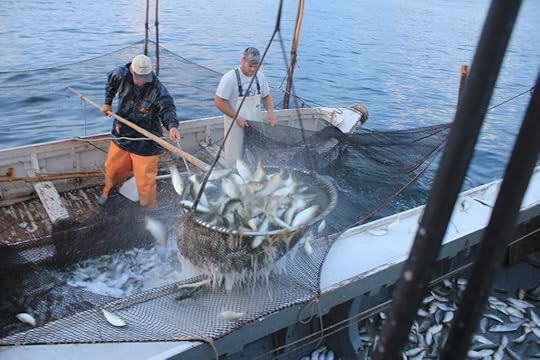The Last of the Pound-Netters

In the course of reporting on the menhaden fight, I spent a day out on one of the big, industrial-style ships that now dominate the fishery. But I also got a chance to look in on an old-style way of fishing for menhaden that reminded me of the classic Chesapeake waterman in William B. Warner’s book Beautiful Swimmers. My host, Walter Rogers, manages to eke out a living in the same market as ships that harvest tens of thousands of times more fish per day. It clearly isn’t easy, but he does it. Rogers won’t agree with this. But to me this suggests that it’s possible to have a reduced menhaden fishery and actually create more jobs by moving away from the current model of an industrial fishery dominated by a single large company, Omega Protein. Moreover, that model encourages people to become independent small businessmen, not just wage slaves. And that’s something to think on as the Atlantic States Marine Fisheries Commission meets tomorrow to decide the fate of the menhaden:
I headed out of Cockrell Creek before dawn one morning, past Reedville’s restored smokestack, now brightly lighted up against an indigo sky. Walter Rogers, a 48-year-old college-educated father of two, was at the helm of a classic Chesapeake Bay deadrise, the Glenna Fay, 40 feet long, powered by a 1940s Detroit Diesel engine, and with a wooden skiff tagging along behind.
Rogers catches menhaden much as his great-grandfather did, with pound nets. Starting in February, he drives heavy pine poles into the bay bottom, then uses them to arrange his nets into a series of underwater hallways and rooms, divided by chutes. The fish end up in a pound at the end, from which Rogers and a crewman haul them up in a net by hand. It’s hard work, but also beautiful, especially when the sun breaks through the last blue remnants of night and beats a path across the water.
“I love what I do,” said Rogers, and immediately he added, “There are times I hate it. The days when you go out and lose money, or spend money on all that gear.” The regulations. There used to be thousands of pound netters working the Virginia stretch of the Chesapeake, he said. Now it’s down to about 50.
He scooped up a mess of fish in a big net with a handmade cedar handle, cried “Yup!” to signal a man at the winch to help lift the load over the rail of the Glenna Fay. Then he pulled a release cord and the fish showered down like coins into the hold of the boat, till it was shin-deep in menhaden. It looked like the lost age of the Chesapeake Bay watermen, barely hanging on in the twenty-first century, and it was hard to miss the contrast with the big Omega Protein boats.
But Rogers wasn’t buying the role of the artisanal fisherman, or the idea that industrial-scale fishing might be putting him out of business. “Those people on the menhaden boats get vilified as guys with white boots and no teeth,” he said. “But those people are me. They’re working hard, they’re away a lot, they’re doing what they can to feed their families.” For Reedville, that was the only reality that mattered, those 275 jobs. Next to that, all the science and stock assessments were just a heap of meaningless talk.
Then Rogers grimaced and said something that seemed to me to apply about equally to all sides in the war for the future of menhaden: “You’re arguing with people you can’t convince.”
[image error]








